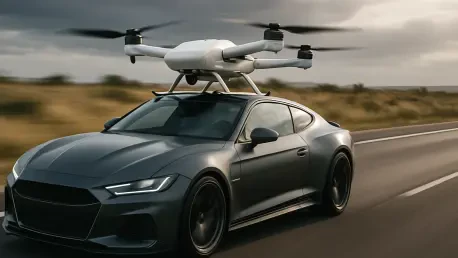What happens when a drone needs to deliver critical medical supplies to an ambulance speeding down a highway at 60 miles per hour? Until recently, such a feat seemed nearly impossible due to the risks of unstable landings, but a groundbreaking technology developed by researchers at the University of Sherbrooke in Canada is changing the game. The DART quadcopter, equipped with an innovative friction-based landing system, has successfully tackled this challenge, opening up new horizons for drone operations in high-stakes, dynamic environments.
The significance of this advancement cannot be overstated. With nearly half of all drone accidents occurring during landing, often due to wind gusts or rigid gear limitations, the ability to safely touch down on fast-moving vehicles addresses a critical gap in uncrewed aerial vehicle (UAV) technology. This development not only enhances safety but also paves the way for transformative applications in emergency response, logistics, and surveillance, where time and precision are paramount.
Revolutionizing Drone Landings with Cutting-Edge Tech
Picture a drone descending rapidly toward a pickup truck racing along at 68 miles per hour. Instead of faltering under turbulent air or bouncing off on impact, the DART quadcopter executes a flawless touchdown. This remarkable capability stems from a friction-based landing system that redefines how drones interact with moving platforms, pushing the boundaries of what UAVs can achieve in real-world scenarios.
At the heart of this technology lies a strategic combination of design elements tailored for high-speed challenges. Unlike traditional landing gear, which often struggles with stability, this system prioritizes adaptability, ensuring the drone can handle the chaos of dynamic conditions. The implications are profound, as industries reliant on timely drone operations now have a tool to overcome one of their toughest obstacles.
Addressing the Critical Gap in Drone Landing Safety
Drone technology has become indispensable across sectors like logistics and emergency services, yet a staggering statistic looms over its progress: almost 50% of UAV mishaps happen during landing. Factors such as sudden wind shifts or the inability of standard gear to absorb impact often lead to crashes, especially when attempting to land on platforms in motion. This vulnerability has long hindered the full potential of drones in critical missions.
Particularly in scenarios involving high-speed vehicles—think ambulances, patrol cars, or cargo ships—the stakes are even higher. A failed landing can mean delayed deliveries of life-saving supplies or compromised surveillance data. The urgent need for a reliable solution has driven researchers to rethink landing mechanisms from the ground up, focusing on resilience and precision under pressure.
Unveiling the DART Quadcopter’s Breakthrough Features
The DART quadcopter, short for Direct Approach Rapid Touchdown, introduces a suite of innovations designed specifically for fast-moving landings. Its rapid descent strategy minimizes exposure to disruptive air currents, slashing the risk of being knocked off course. Just before contact, a pitch-leveling maneuver aligns the drone perfectly, safeguarding its propellers from potential damage.
What truly sets this system apart are its friction shock absorbers (FSAs), which soak up impact energy to prevent bouncing or flipping on touchdown. Coupled with reverse thrust (RVT), the drone locks securely onto the moving surface, countering sliding forces. Testing has shown astounding results, with 38 consecutive successful landings on a truck speeding at 68 miles per hour, expanding the safe flight envelope by a factor of 38 compared to conventional setups.
This isn’t just a minor upgrade; it’s a complete overhaul of landing dynamics. The ability to initiate leveling maneuvers under a vastly wider range of conditions means drones can now operate in environments previously deemed too risky. Such advancements signal a leap forward for UAV reliability in unpredictable settings.
Insights from Experts and Real-World Testing
Researchers at the University of Sherbrooke have expressed confidence in the transformative impact of this technology. A lead team member noted, “The aim was to build a system that excels even in the most chaotic real-world conditions, not just in controlled tests.” This vision came to life during rigorous trials where the DART quadcopter consistently landed on a high-speed pickup truck without faltering.
Field operators involved in the tests were equally impressed by the system’s performance. Reports highlighted how the drone stayed anchored despite strong crosswinds, a feat attributed to the seamless integration of FSAs and RVT. These firsthand accounts underscore the potential for this technology to redefine operational standards in drone missions.
The data backs up the enthusiasm. With each test demonstrating precision and stability, the results offer a compelling case for broader adoption. This validation from both experts and practical application builds a strong foundation for confidence in the system’s real-world utility.
Real-World Applications and Implementation Strategies
Industries stand to gain immensely from integrating this friction gear into drone operations, especially in high-pressure contexts. For emergency services, equipping UAVs with this technology could enable the delivery of vital supplies to ambulances on the move. A practical first step involves mapping key routes and vehicle types for targeted deployment to maximize impact.
In maritime logistics, the system offers a solution for supply drops to ships navigating rough seas. By fine-tuning descent speeds and thrust settings, drones can adapt to variable conditions, ensuring consistent success. This opens up possibilities for faster, safer resupply missions in challenging marine environments.
Surveillance operations, such as border monitoring or traffic oversight, could also benefit significantly. Landing drones on patrol vehicles becomes feasible with proper operator training in rapid descent and alignment techniques. Retrofitting existing fleets with FSAs and RVT, followed by controlled testing, ensures seamless integration into ongoing missions, unlocking new levels of operational flexibility.
Looking back, the journey of the DART quadcopter stands as a testament to ingenuity in overcoming one of drone technology’s most persistent hurdles. The successful landings on speeding vehicles marked a turning point, proving that dynamic environments no longer need to limit UAV potential. As industries reflect on this milestone, the path forward becomes clear: scaling up adoption through targeted pilot programs, investing in operator training, and exploring applications across diverse platforms promise to solidify drones as indispensable tools in critical operations.









